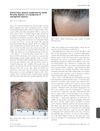TLDR Sarcoidosis can mimic other skin disorders, making diagnosis challenging.
A 73-year-old woman presented with pruritic scalp nodules and plaques, hairline regression, and eyebrow alopecia. Biopsies revealed granulomatous dermatitis consistent with sarcoidosis and frontal fibrosing alopecia (FFA). Elevated angiotensin-converting enzyme levels and normal pulmonary tests supported systemic sarcoidosis diagnosis. Treatment included Kenalog injections, tetracycline, hydroxychloroquine, and ketoconazole shampoo, leading to partial lesion resolution and symptom improvement. This case highlighted the diagnostic challenge of sarcoidosis mimicking other cutaneous disorders and emphasized the importance of scalp biopsy in patients with severe pruritus and hair loss.
 5 citations
,
April 2014 in “The American Journal of Dermatopathology”
5 citations
,
April 2014 in “The American Journal of Dermatopathology” Foreign-body granuloma may be a marker for late-stage Lichen Planopilaris and should be considered in diagnosis.
10 citations
,
January 2014 in “International Journal of Trichology” Sarcoidosis can cause scarring hair loss on the scalp, which is rare.
 25 citations
,
March 2013 in “British Journal of Dermatology”
25 citations
,
March 2013 in “British Journal of Dermatology” Woman has discoid lupus, frontal fibrosing, and androgenetic alopecia.
 329 citations
,
January 1997 in “Journal of the American Academy of Dermatology”
329 citations
,
January 1997 in “Journal of the American Academy of Dermatology” Frontal fibrosing alopecia is a hair loss condition in postmenopausal women, similar to lichen planopilaris, with ineffective treatments.
 7 citations
,
July 2019 in “Clinics in Dermatology”
7 citations
,
July 2019 in “Clinics in Dermatology” Hair loss can indicate or worsen with systemic diseases, and treating the underlying condition is important.
 March 2014 in “Journal of The American Academy of Dermatology”
March 2014 in “Journal of The American Academy of Dermatology” The document lists various dermatology topics, treatments, and diagnostic methods.
 March 2020 in “Clinical research in dermatology”
March 2020 in “Clinical research in dermatology” Two unusual cases showed that Lichen Planopilaris can look like other skin conditions and need early treatment to protect hair.
February 2009 in “Journal of the American Academy of Dermatology”  14 citations
,
September 2016 in “Journal of Cutaneous Pathology”
14 citations
,
September 2016 in “Journal of Cutaneous Pathology” The document concludes that new methods improve the accuracy of diagnosing scalp alopecia and challenges the old way of classifying it.







